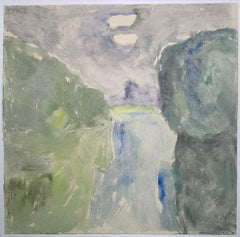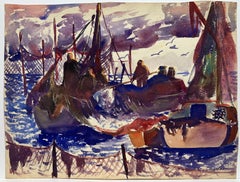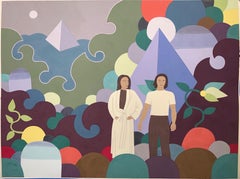Want more images or videos?
Request additional images or videos from the seller
1 of 8
Leon SaulterWest Side Piers (Art Deco Manhattan New Your City cityscape painting)1936
1936
$2,000List Price
About the Item
- Creator:Leon Saulter (1908 - 1986, American, Polish)
- Creation Year:1936
- Dimensions:Height: 33.5 in (85.09 cm)Width: 40.5 in (102.87 cm)Depth: 1 in (2.54 cm)
- Medium:
- Movement & Style:
- Condition:
- Gallery Location:Wilton Manors, FL
- Reference Number:1stDibs: LU24521431393
About the Seller
4.9
Platinum Seller
Premium sellers with a 4.7+ rating and 24-hour response times
Established in 2007
1stDibs seller since 2015
420 sales on 1stDibs
Typical response time: 2 hours
Authenticity Guarantee
In the unlikely event there’s an issue with an item’s authenticity, contact us within 1 year for a full refund. DetailsMoney-Back Guarantee
If your item is not as described, is damaged in transit, or does not arrive, contact us within 7 days for a full refund. Details24-Hour Cancellation
You have a 24-hour grace period in which to reconsider your purchase, with no questions asked.Vetted Professional Sellers
Our world-class sellers must adhere to strict standards for service and quality, maintaining the integrity of our listings.Price-Match Guarantee
If you find that a seller listed the same item for a lower price elsewhere, we’ll match it.Trusted Global Delivery
Our best-in-class carrier network provides specialized shipping options worldwide, including custom delivery.You May Also Like
Gris - project, circa 1928n Gouache on cardboard
By Eric Bagge
Located in PARIS, FR
Éric Bagge (1890-1978)
Grey - project, circa 1928
Gouache on cardboard
Signed and numbered “183”
Dimensions : 29,7 x 21 cm
Architect and interior designer Eric Bagge was born in the...
Category
1920s Art Deco Abstract Paintings
Materials
Gouache
Brown - project, circa 1928n Gouache on cardboard
By Eric Bagge
Located in PARIS, FR
Éric Bagge (1890-1978)
Brown - project, circa 1928
Gouache on cardstock
Signed and numbered “183bis”
Dimensions : 29,7 x 21 cm
Architect and interior designer Eric Bagge was born in...
Category
1920s Art Deco Abstract Paintings
Materials
Gouache
Art Deco Horses in Blue - Horse Show Illustration by Female Illustrator
By Robin Artine Smith
Located in Miami, FL
Work is matted but not framed.
Painter, Designer, Illustrator born on July 18, 1903 in Warren Arkansas. Studied at the Chicago Art Institute; Northwestern University; Vienne, Austria; with Eliot O’Hara and Hubert Ropp. Member of the following organizations: Dallas Art Association; Texas Fine Arts Association; National Association of Watercolor Artists; and the Texas watercolor Society. Smith exhibited at: American Watercolor Society in 1945, 1948 and 1952; with National Assn. of Watercolor Artists in 1945, 1946, and 1948; Artists Alliance in Dallas in 1943 (awarded prize), in 1944 (awarded prize), in 1945-46 and 1948-1950, 1952-53 with prizes awarded in 1948 and 1953; the Texas General Exhibition from 1943 through 1946, 1948-49; with the Texas Watercolor Society from 1950-52 with prizes won in 1950 and 1951, 1957; with the Southern States Arts League in 1944 and 1945; Texas Fine Arts Association in 1945 and awarded prize and with the Texas Artist Group consecutively from 1945.Smith’s work is in the collection of the Dallas Museum of Fine Arts.
Her one-man shows were in Austin, Texas in 1948; in San Antonio in 1951 and Dallas in 1951. Smith’s work is in the collection of the Dallas Museum of Fine Arts.
Original pastel and gouache on paper by Robin Artine Smith...
Category
1930s Art Deco Animal Paintings
Materials
Gouache, Pastel
$14,000
H 8.4 in W 12.5 in D 1 in
New Chess Tiles, Purple and Coral Squares on Black, Primary Geometry, Abstract
By Natalia Roman
Located in Barcelona, ES
These series of paintings by Natalia Roman gather their inspiration from geometric, minimalist shapes and paintings from the beginning of Modernism, with a special emphasis on Art De...
Category
2010s Art Deco Abstract Paintings
Materials
Acrylic, Paper
$540 Sale Price
25% Off
H 28 in W 40 in
Untitled (Black and White Abstraction)
Located in Astoria, NY
Susumu Shingu (Japanese, b. 1937), Untitled (Black and White Abstraction), Mixed Media Collage on Paper, 1964, signed and dated lower left, painted white trim wood frame. Image: 19" ...
Category
1960s Abstract Mixed Media
Materials
Paper, Mixed Media, Oil, Acrylic, Gouache
Vargas-Suarez Universal 'Syntax 14'
By Vargas-Suarez Universal
Located in New York, NY
Syntax 14 (2023)
Acrylic gouache, oil enamel on paper
12x10 inches
Signed and dated by the artist on verso
Vargas-Suarez Universal (b. 1972) is an artist based between New York Cit...
Category
2010s Contemporary Abstract Paintings
Materials
Oil, Acrylic, Gouache, Archival Paper
Vargas-Suarez Universal 'Syntax 22'
By Vargas-Suarez Universal
Located in New York, NY
Syntax 22 (2023)
Acrylic gouache, oil enamel on paper
12x10 inches
Signed and dated by the artist on verso
Vargas-Suarez Universal (b. 1972) is an artist based between New York Cit...
Category
2010s Contemporary Abstract Paintings
Materials
Oil, Acrylic, Gouache, Archival Paper
Vargas-Suarez Universal 'Syntax 12'
By Vargas-Suarez Universal
Located in New York, NY
Syntax 12 (2023)
Acrylic gouache, oil enamel on paper
12x10 inches
Signed and dated by the artist on verso
Vargas-Suarez Universal (b. 1972) is an artist based between New York Cit...
Category
2010s Contemporary Abstract Paintings
Materials
Oil, Acrylic, Gouache, Archival Paper
Vargas-Suarez Universal 'Syntax 19'
By Vargas-Suarez Universal
Located in New York, NY
Syntax 19 (2023)
Acrylic gouache, oil enamel on paper
12x10 inches
Signed and dated by the artist on verso
Vargas-Suarez Universal (b. 1972) is an artist based between New York Cit...
Category
2010s Contemporary Abstract Paintings
Materials
Oil, Acrylic, Gouache, Archival Paper
Vargas-Suarez Universal 'Syntax 17'
By Vargas-Suarez Universal
Located in New York, NY
Syntax 17 (2023)
Acrylic gouache, oil enamel on paper
12x10 inches
Signed and dated by the artist on verso
Vargas-Suarez Universal (b. 1972) is an artist based between New York Cit...
Category
2010s Contemporary Abstract Paintings
Materials
Oil, Acrylic, Gouache, Archival Paper
More From This Seller
View AllRussian Landscape (abstract painting)
Located in Wilton Manors, FL
Yuri Larin (1936-2014). Landscape, 1986. Watercolor on paper, 16.5 x 17 inches. Mounted on cardboard sheet measuring 24 x 28 inches. Signed and dated lower left. Excellent condition. Image is painted on verso side of block print wallpaper...
Category
1980s Abstract Abstract Paintings
Materials
Paper, Watercolor
$900 Sale Price
50% Off
Provincetown (Cape Cod landscape)
By James Floyd Clymer
Located in Wilton Manors, FL
Beautiful abstract painting by American artist, James Floyd Clymer (1893-1982). At the Weir Trap, ca. 1930. Watercolor and pencil on paper measures 15 x 20 inches. Signed lower margi...
Category
Early 20th Century Abstract Abstract Paintings
Materials
Watercolor, Rag Paper, Pencil
$450 Sale Price
50% Off
Cubist portrait
Located in Wilton Manors, FL
Bernard Segal (1907-1986). Cubist portrait, ca. 1960. Gouache and watercolor on paper, sheet measures 10 x 13.5 inches. Unsigned. Estate stamp on vers...
Category
Mid-20th Century Cubist Abstract Paintings
Materials
Paper, Gouache
$350 Sale Price
50% Off
Man & Woman (Comanche Native American surrealist painting)
Located in Wilton Manors, FL
Man & Woman, ca. 1975-80. Gouache on Arches rag paper, Sheet measures 23 x 30 inches. Image measures 22 x 29 inches. Signed lower left. Excellent condition. Unframed.
Category
1970s Surrealist Abstract Paintings
Materials
Gouache, Rag Paper
Fishing Boat in Storm
By James Floyd Clymer
Located in Wilton Manors, FL
James Floyd Clymer (1893-1982), ca.1930. Watercolor and pencil on paper measures 15 x 20 inches. Signed lower margin.
Tape residue marks on back.
James Floyd Clymer ( 1893-1982...
Category
Early 20th Century Abstract Abstract Paintings
Materials
Watercolor, Rag Paper, Pencil
Cactus Landscape (Comanche Native American surrealist painting)
Located in Wilton Manors, FL
Cactus Landscape, ca. 1975-80. Gouache on Arches rag paper, Sheet measures 23 x 30 inches. Image measures 22 x 29 inches. Signed lower left. Excellent condition. Unframed.
Category
1970s Surrealist Abstract Paintings
Materials
Gouache, Rag Paper
Recently Viewed
View AllMore Ways To Browse
Tania Dibbs
White Plaster Art Canvas
Abstract Art Non Figurative
Adam Sultan
Brion Gysin
California Abstract Expressionist Art
Japanese Diptych
John Joy
Left Bank Art
Lilly Muth
Matt Enger
Nancy Seibert
Oil Painting Signed By Prince 1973
Palette Knife Abstract Landscape
Richard Hudson
Three Sisters Art
Vintage Fantasy Posters
Vintage Kitsch Art


